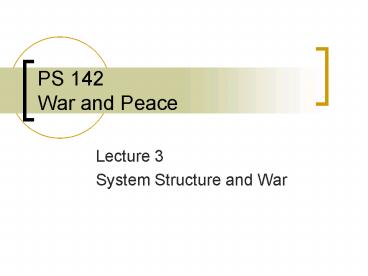PS 142 War and Peace - PowerPoint PPT Presentation
1 / 20
Title:
PS 142 War and Peace
Description:
Austria-Hungary. Germany. What is the Concentration of Capabilities? ... Austria-Hungary. Germany. Alliance Tightness. No change in polarity but alliances are looser ... – PowerPoint PPT presentation
Number of Views:101
Avg rating:3.0/5.0
Title: PS 142 War and Peace
1
PS 142War and Peace
- Lecture 3
- System Structure and War
2
What is the International System?
- Set of actors that are
- Self-Contained
- Interactive
- Interdependent
- Most theories focus on states as the actors in
the system - Increasing emphasis on non-state actors
- IOs, NGOs, transnational groups
3
What is System Structure?
- Two (relatively) unchanging aspects of structure
- Anarchy is the ordering principal
- States are the central actors
- Theories of system structure and war largely
ignore non-state actors - Three variable aspects of structure
4
What is System Structure?
- Polarity
- Number of major actors in the system
- Capability concentration
- Distribution of power across major actors
- Alliance Tightness
- Reinforcing or cross-cutting ties
5
What is Polarity?
- Number of Great Power states in the system
- Bipolar US USSR in Cold War
- Multi-polar UK, Germany, France, Japan, Italy,
US, USSR in 1930s - Today uni-polar?
- Number of Great Power alliances groups in the
system - Bipolar vs. multi-polar
6
Examples of PolarityPre-WWI Europe
- May differ for states alliances
- Pre-WWI multi-polar in terms of states
UK
Germany
France
Austria-Hungary
Russia
7
Examples of PolarityPre-WWI Europe
- But largely bipolar in terms of alliances
- Neither is wrong capture different parts of
system
UK
Germany
France
Austria-Hungary
Russia
8
What is the Concentration of Capabilities?
- Distribution of power across Great Power states
in the system - Even vs. Uneven
- Distribution of power across Major Power
alliances groups - Capability aggregation model
9
The Concentration of Capabilities
- Concentration may vary when polarity is constant
- Concentration is even across states, but uneven
across alliances
UK 20
Germany 20
France 20
Austria-Hungary 20
Russia 20
10
The Concentration of Capabilities
- Now it is even is even across alliances, but
uneven across states
UK 30
Germany 45
France 10
Austria-Hungary 5
Russia 10
11
Alliance Tightness
- Ties reinforcing or cross-cutting
- NATO WTO
- Pre-WWI
- Here alliances are tight
UK
Germany
France
Austria-Hungary
Russia
12
Alliance Tightness
- No change in polarity but alliances are looser
UK
Germany
France
Austria-Hungary
Russia
13
How does System Structure cause war?
- Leaders initiate wars, not the system
- Any systemic theory of war must explain how
system alters leader calculations - Key concept Systemic Uncertainty
- Who will oppose whom with how much capability?
14
How Does System Structure Create Systemic
Uncertainty
- Polarity many actors high uncertainty
- Need many predictions
- Concentration of Capabilities even distribution
high uncertainty - More predictions are relevant
- Tightness Loose alliances high uncertainty
- More difficult to predict behavior based on
alliances
15
How Does Systemic Uncertainty Relate to War?
- Waltz Uncertainty causes errors
- Buckpassing
- Entrapment
- War is a result of reckless errors
- Certainty allows states to avoid war
16
How Does Systemic Uncertainty Relate War?
- Singer Deutsch Uncertainty creates caution
- War is a result of confidence in victory
- Fear of possible defeat deters war
17
How Does Systemic Uncertainty Cause War?
- What does the evidence show?
- Very mixed results
- Data suggest no relationship
- Why?
- Is systemic theory a waste of time?
18
The Contingent Effects of Systemic Uncertainty
- Key to argument is the impact of risk
- Individuals respond to risk in different ways
- Risk-Propensity
- Risk Acceptance
- Risk Aversion
- Effect of systemic uncertainty depends on risk
propensity of leaders
19
The Contingent Effects of Systemic Uncertainty
- For risk-acceptant leaders Waltz should be
right - For risk-averse leaders Singer Deutsch should
be right - Huth, Bennett Gelpi (1992) show this effect
20
What States Are Risk Takers?
- States facing problems
- Poor economy
- Declining power
- Internal unrest
- Non-democracies
- Leaders personalities
- Driven to take risks?































